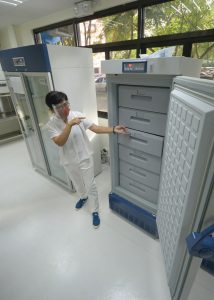
THE VACCINE simulation exercise was successful, but government officials noted that only the logistics side of the exercise was conducted owing to the lack of facilities for vaccines that need special cold storage facilities.
In an interview over the Davao City Disaster Radio, Dr. Ashley Lopez, Davao City COVID-19 Task Force focal person, it was the first time for the city to participate in the simulation which was conducted in coordination with the regional offices of Department of Health, Department of Interior and Local Government, Southern Philippines Medical Center (SPMC), and other agencies.
But, Lopez confirmed that one of the challenges is whether the vaccines that are scheduled to arrive in the city Friday would need special cold storage facilities, like those of Pfizer which need to be placed in a facility that would sustain the temperature at -70 degreeCelsius.
“Mao nga amo gi prepare sa simulation ang pinaka extreme kay sa tanan vaccine mao na pinaka lisud nga i-manage ang Pfizer,” he explained as other vaccines need only to maintain temperatures between 2 and 8 degree Celsius.
” We have adequate refrigerators for that positive 2 and 8 in our health centers,” he added.
Another challenge, he said, is that most of the storage facilities, including those at the SPMC were made not for vaccines but for other uses.
“If kung muabot ang Pfizer sa February 12 wala silay kabutangan for SPMC, that is why the city government of Davao through the approval of Mayor Sara Duterte, misugot sya nga gamiton ang ultra low freezer diha sa Los Amigos Molecular nga kaya mo accommodate up to -80 (degree Celsius),” he added.
Interior and Local Government Regional Director Alex Roldan also said the component of the simulation where the actual vaccination procedure would have been done was eliminated because of the issue of the special cold storage facilities.
Lopez said: “We were there earlier together with the DILG and all other agencies vital para ma figure out ang time motion gikan sa end to end transport of the vaccine.”
He pointed out that the goal was to establish a timeline as well as the motion between the unloading of the vaccines at the airport and transporting them to the vans where these will be refrigerated.
“Ang atoang level diri, atoang responsibility gikan sa pag landing sa eroplano sa tarmac and unload sa cargo padulong didto sa van nga naay refrigerator para ikarga ang vaccine,” he explained, adding that part of the exercise was the deployment of a security unit in coordination with the Civil Aviation Authority and the City Transport and Traffic Management Office.
He said the simulation exercise showed that the loading of the vaccines to the waiting vans took nine minutes. It took 35 minutes between the unloading of the cargo until its arrival at the facility
of the SPMC.
“So wala gyud mi na experience nga traffic during sa convoy naa lang ta gamay issue ddto sa pag unload didtoa lang madugay because gikan sa eroplano pag unload sa commodity it took us about 18 minutes hantod masulod ang items ddto sa freezer van,” he added.
What he would suggest, he added, is for the freezer vans to wait for the vaccines near where the doorsteps of the plane, something that the CAAP needs to facilitate.
